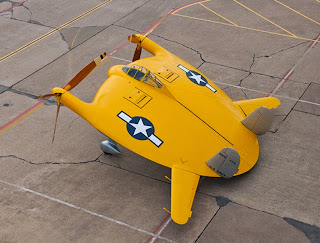This week, with a little delay, we reach position number three of our “different” aircrafts list. This rank is for the McDonell XG-85 “Globin”. This strange aircraft was a parasite fighter created to protect the B36 being transported in its interior. The USAF’s idea was that this fighter could escort the bomber which carried it in case of a foe attack.
The XF-85 was a tiny egg shaped craft with peculiar stabilizers. It was build and tested in 1948 but the performances were lower than the foe fighters. This fact and the enormous difficulty of the reattachment to the host aircraft caused the abandonment of the project.
.jpg)
There were two prototypes built, that flew seven times with a total flight time of 2 hours and 19 minutes. Only on three occasions the reattachment to the trapezium was achieved.
The only flight pilot that flew it was McDonell’s Edwin Scott.
Both units are shown in museums, one in the Wright-Patterson (Ohio) and the other at the Strategic Air and Space Museum in Ashland, Nebraska.
Despite its strange look, it flew reasonably good and the USAF continued the study of parasite aircrafts after the cancellation of the program, with even more strange aircrafts.
Here you can find an interesting video of the XF-85 “Goblin” that shows the difficulty of the reattachment.
At the beginning of each new year, we usually have all kind of purposes to improve those aspects of our lives, that have not left us completely satisfied during the last year. Naturally this year couldn´t be an exception and now we all have prepared our list of good intentions for this year.




